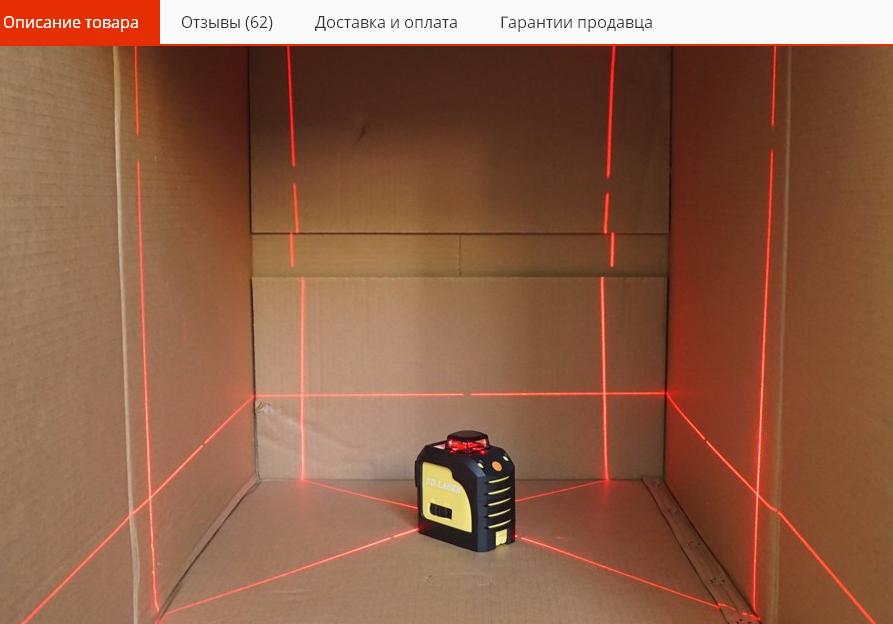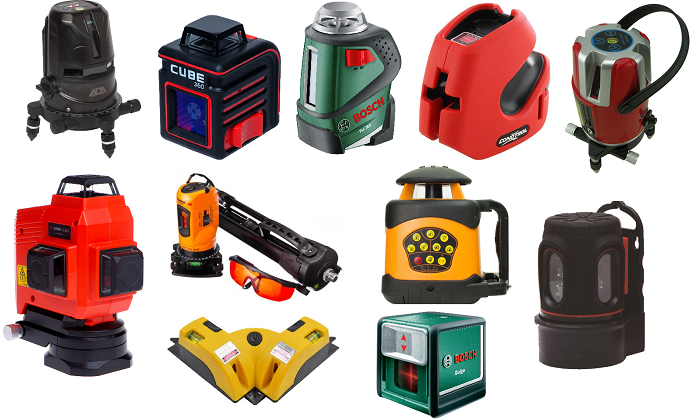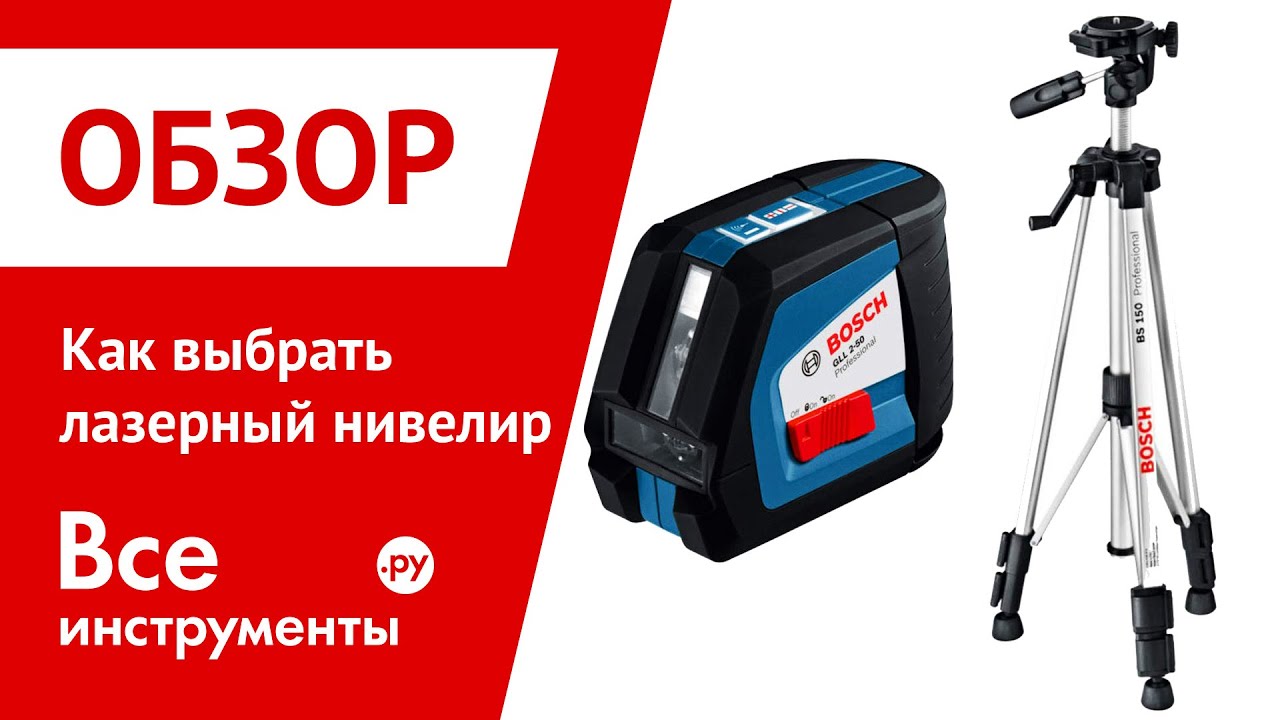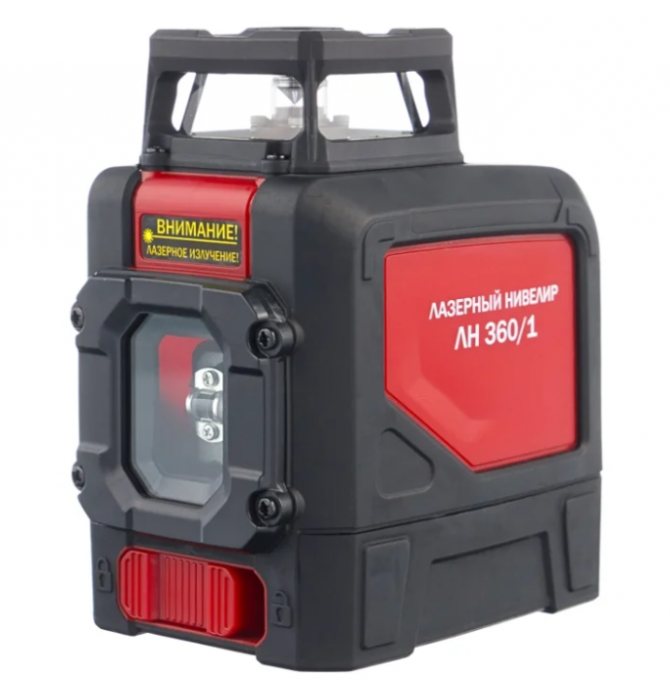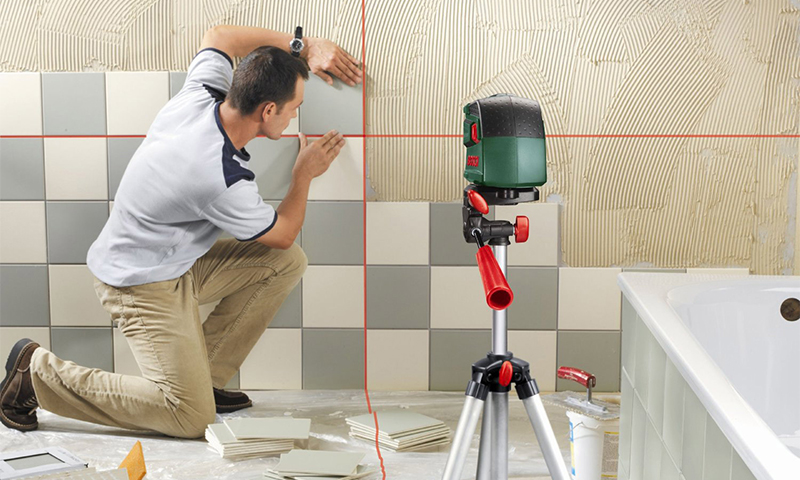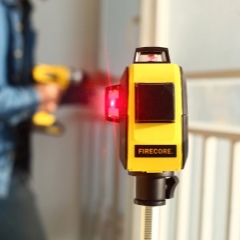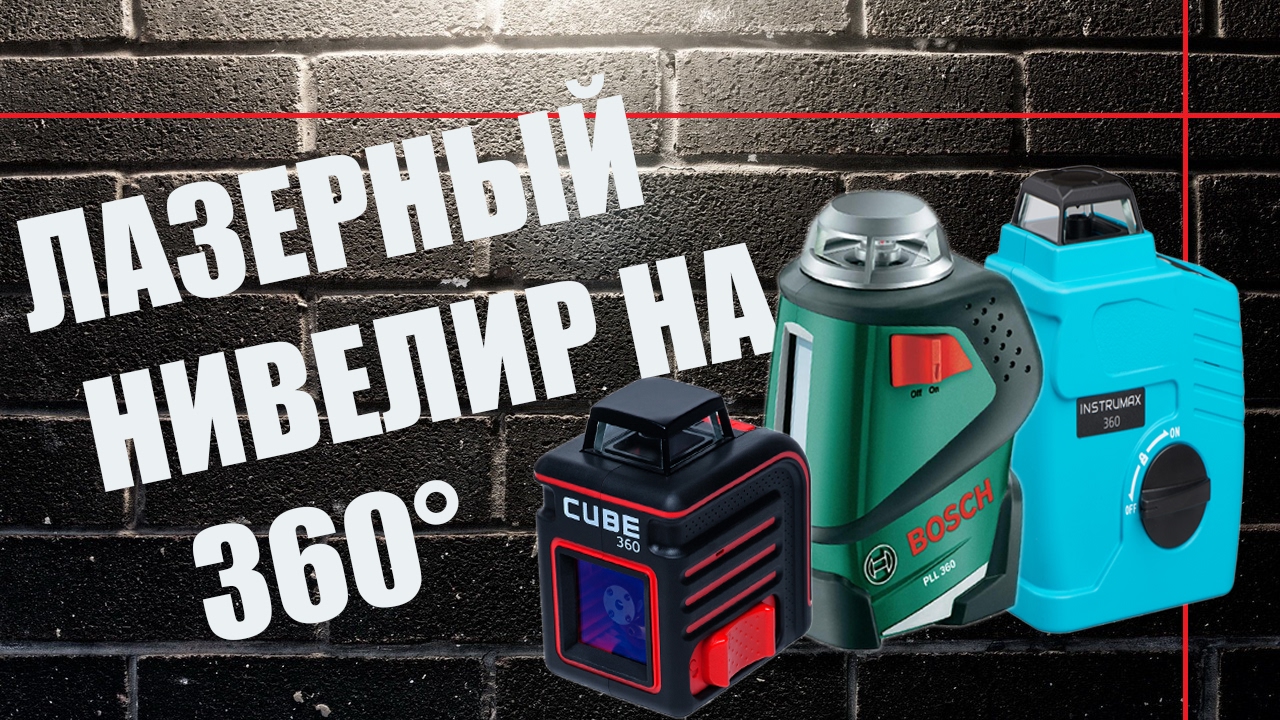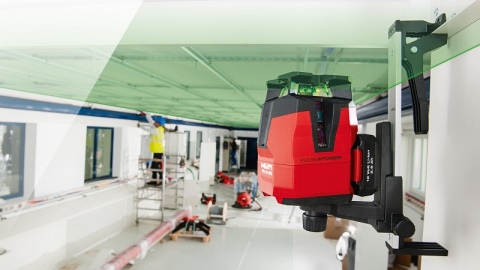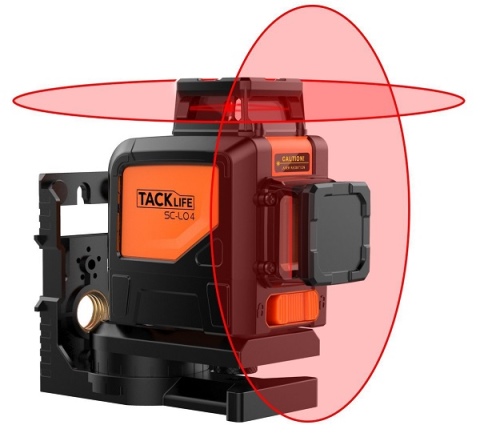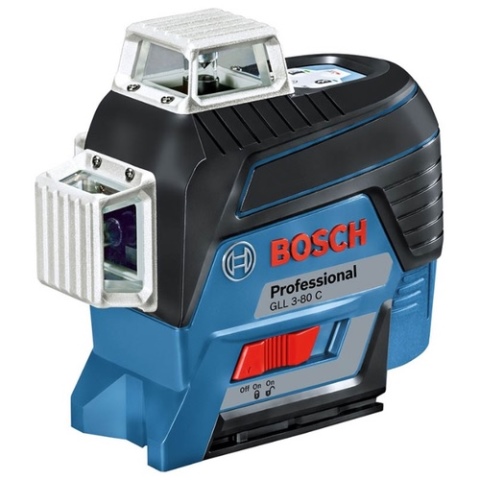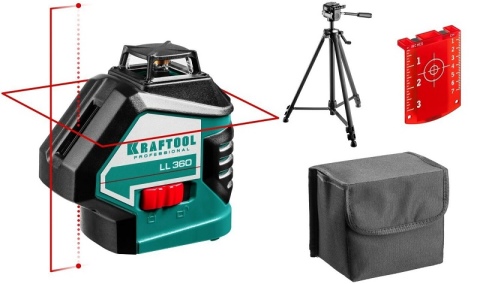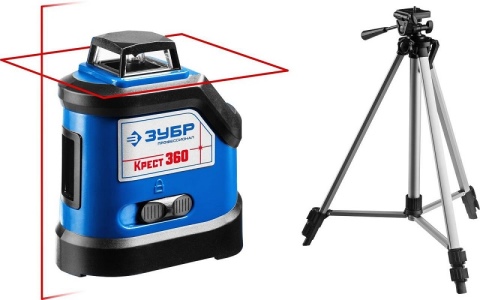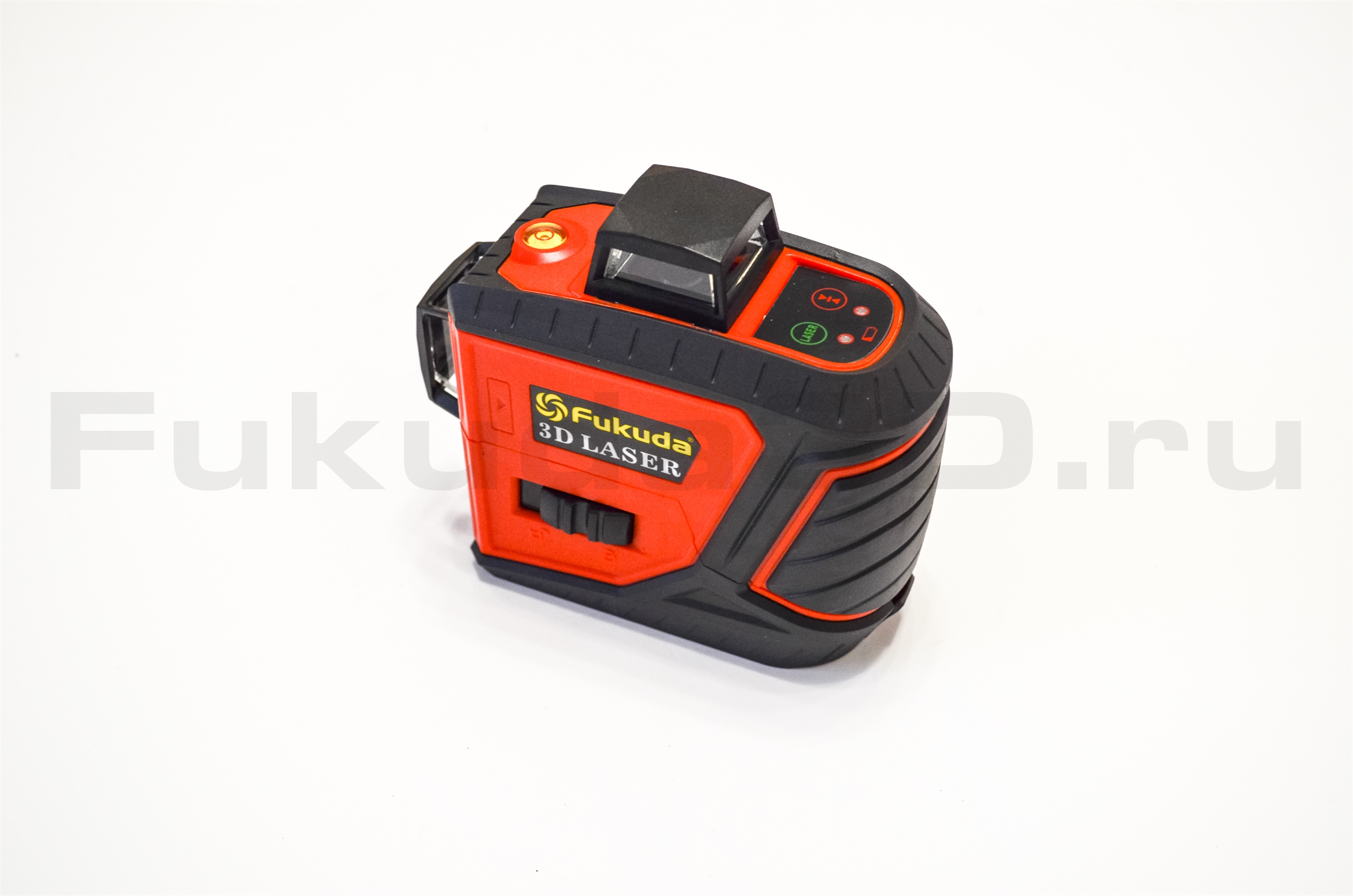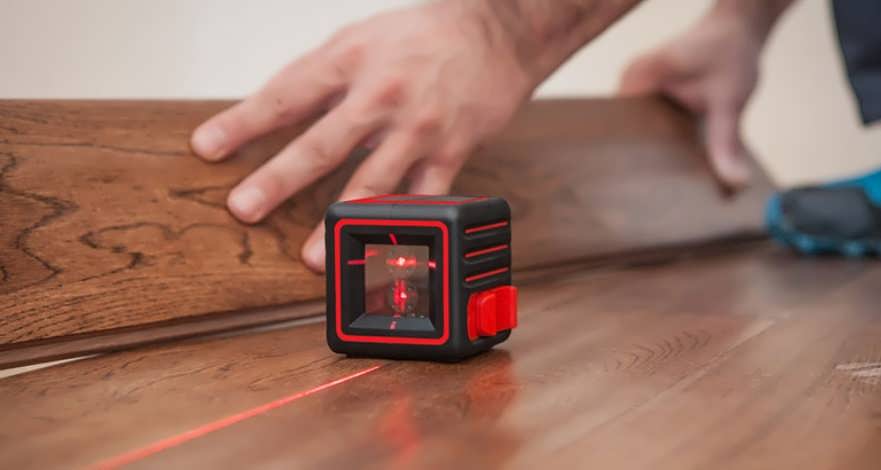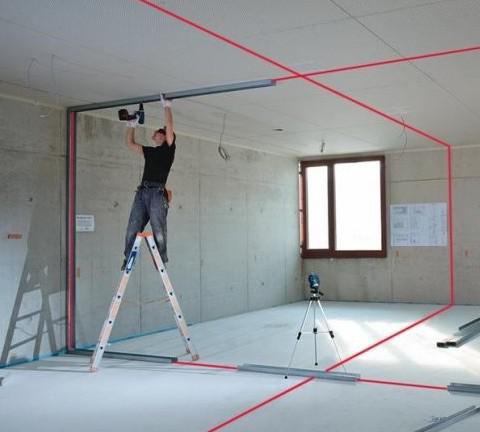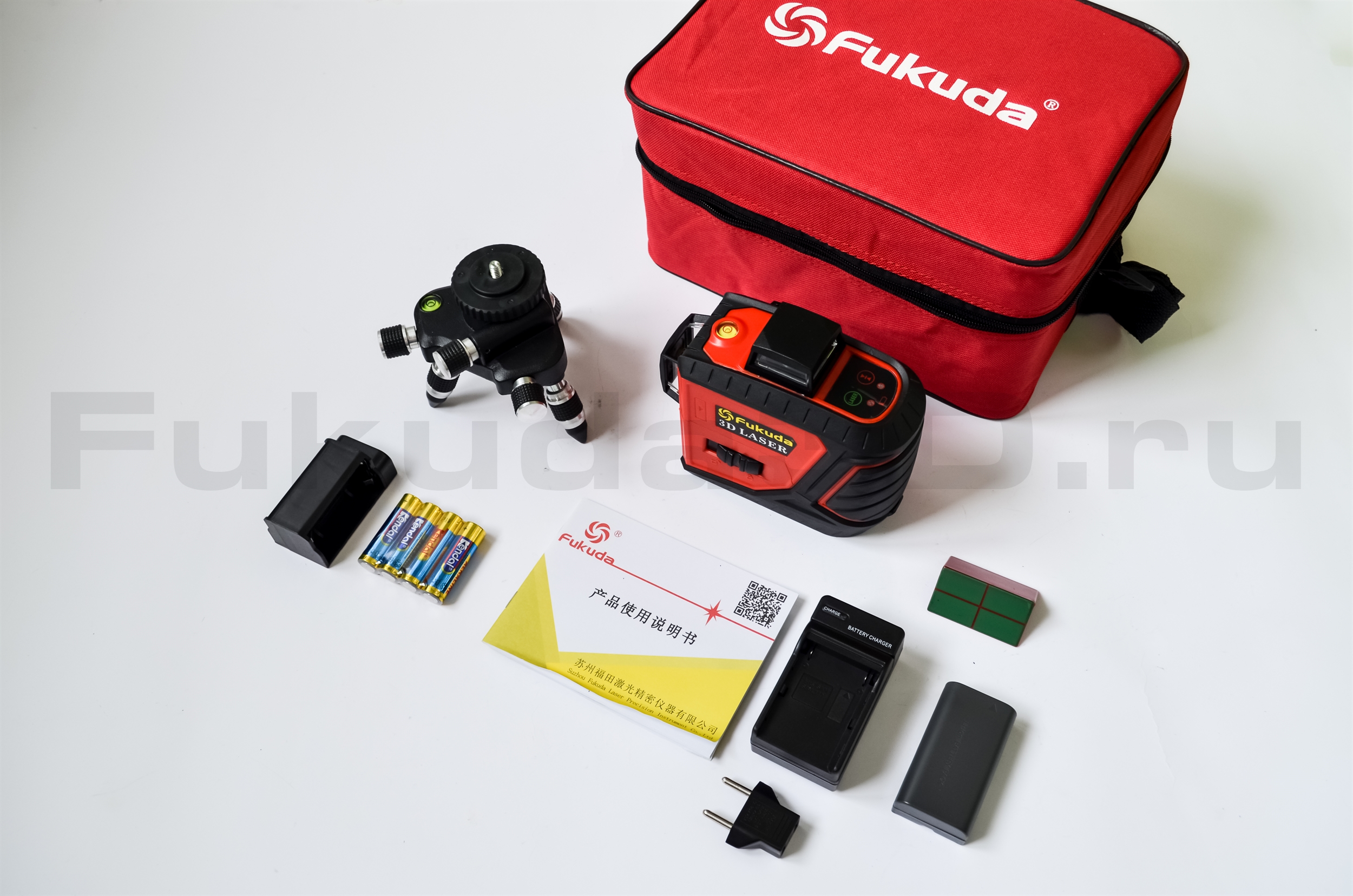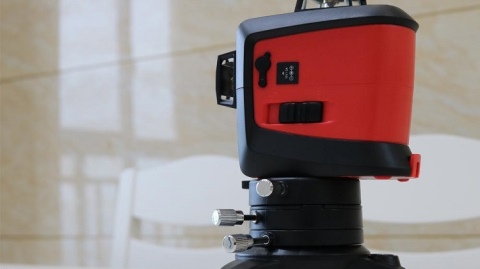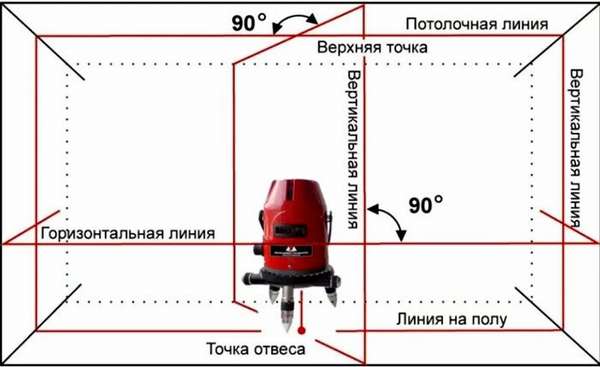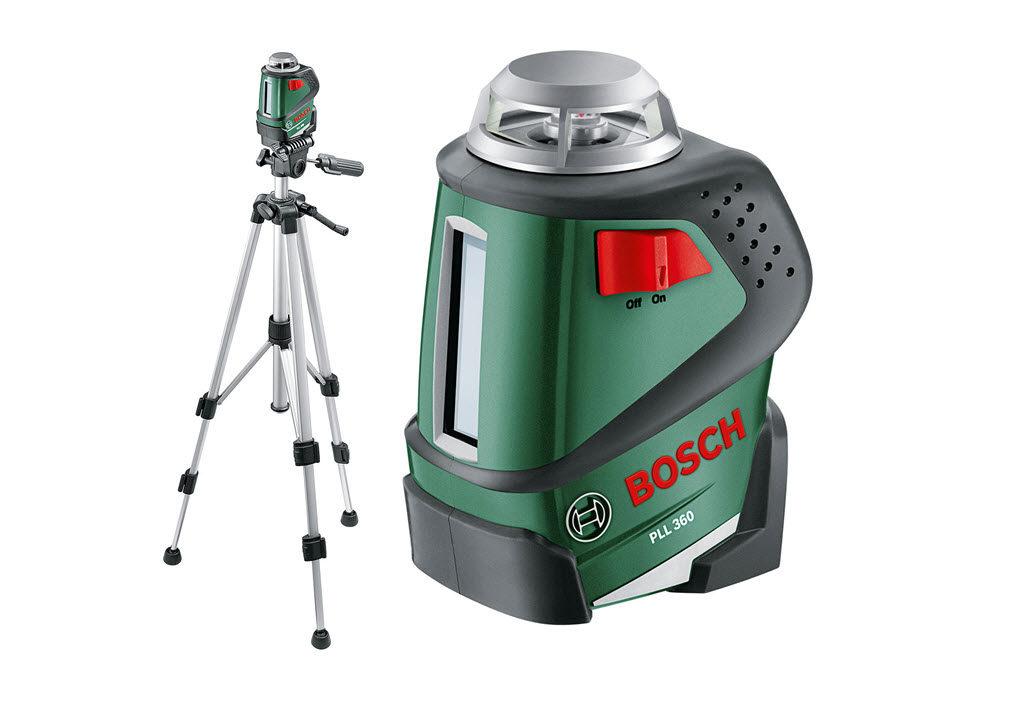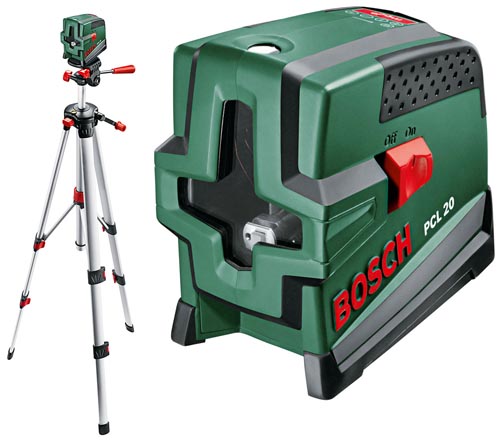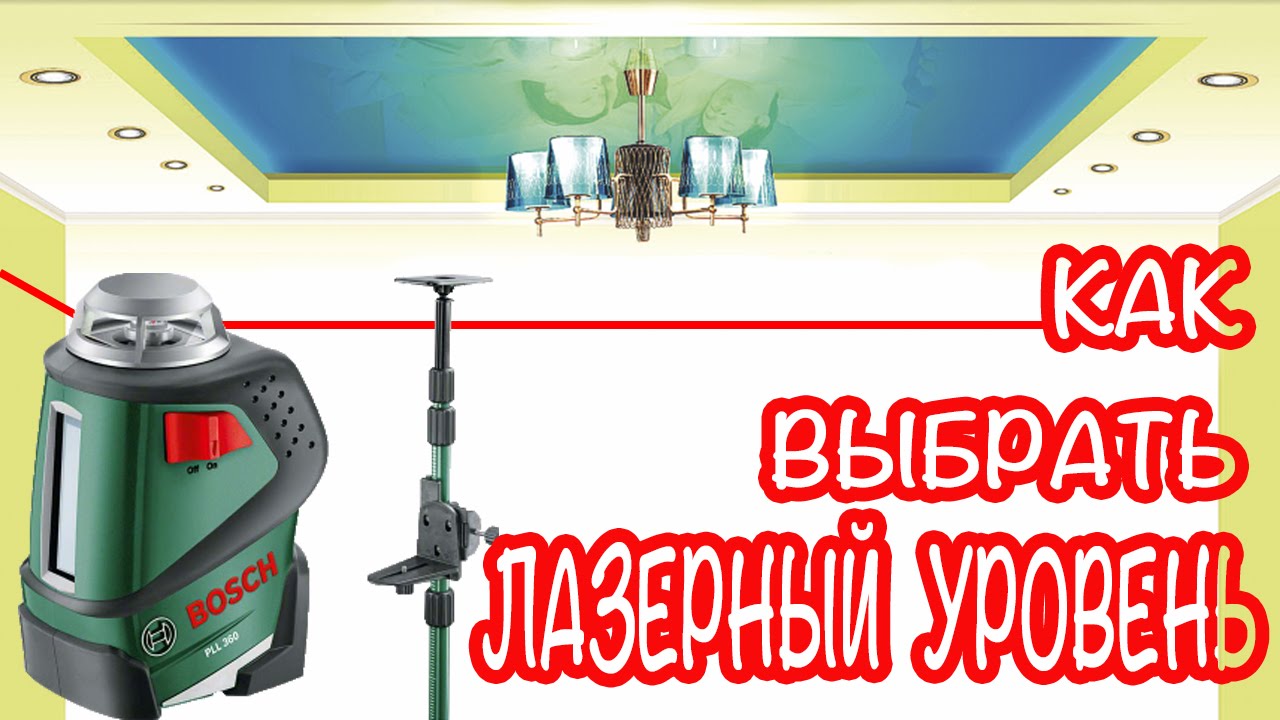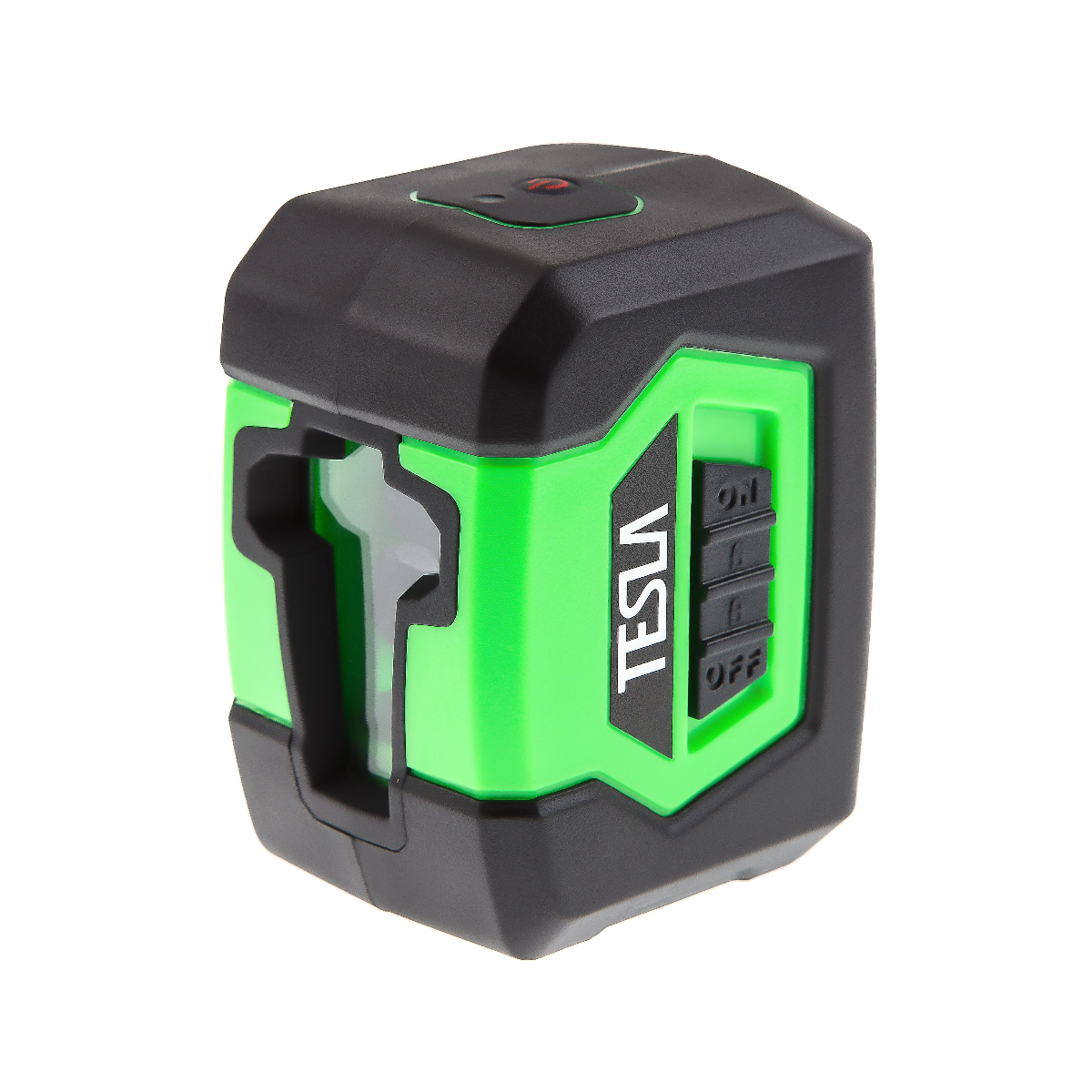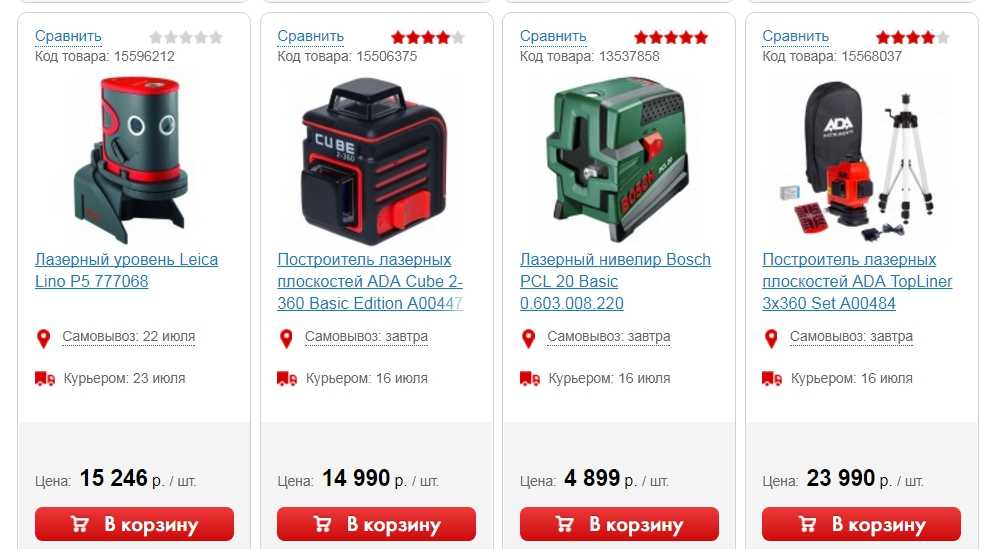Additional components and accessories
Buying a laser level does not mean that now all work will be done quickly and accurately. For normal operation of the device, additional accessories are often required, which are not included in the basic delivery.
Tripod
A tripod is a necessary element of a laser device, especially for devices with a 360-degree projection. Most often, manufacturers offer to purchase tripods, however, sometimes telescopic poles are also used, which are mounted between the floor and the ceiling.
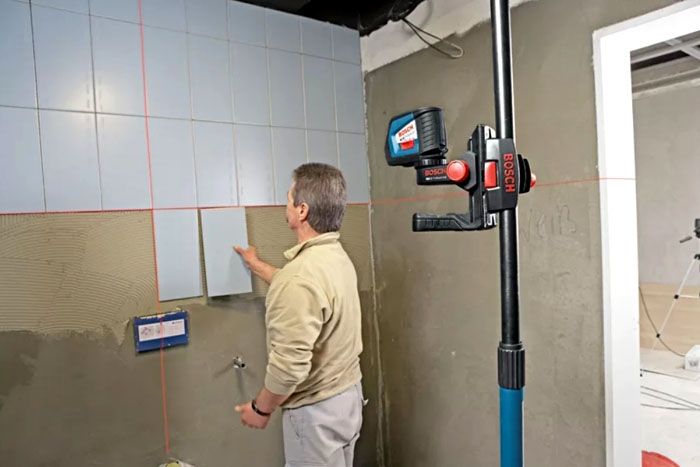 For example, this is very useful for marking a series of parallel lines.
For example, this is very useful for marking a series of parallel lines.
The cheapest tripods can be bought for 1000 - 1500 rubles.
Case
Most often, even the simplest laser level is supplied with a carrying bag or a special case. Remember that the laser levels are equipped with very sensitive optics that are afraid of dust and moisture.
Holder
For light models of levels, special holders can be used. This mount is more affordable. The holder is a device that is fixed on a clip.
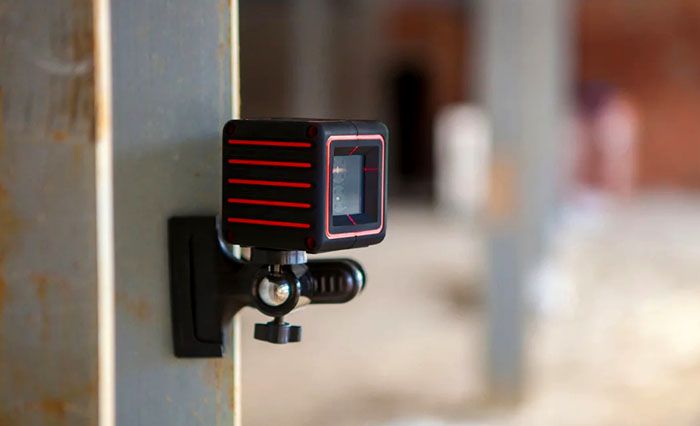 Fastening the laser level to a special holder. True, such a clamp is only suitable for compact models.
Fastening the laser level to a special holder. True, such a clamp is only suitable for compact models.
Glasses
For work in sunny weather, you can purchase special glasses with tinted glass. They help you see the laser beam from the level.
 Laser mark and glasses for working with the level
Laser mark and glasses for working with the level
Such glasses do not have any protective function, they only act as a light filter.
Receiver
However, in some cases, the glasses may not be enough. Then special devices come to the rescue - receivers-reflectors.
 The device captures the beam and helps to establish the distance to the target.
The device captures the beam and helps to establish the distance to the target.
The receiver works like this. When the beam hits the detector, it starts emitting a beep. Thanks to such reflectors, it is easy to understand exactly where the beam is being projected. This device helps to simplify the operation of the laser level, and in some cases to increase its range.
Battery
AA or AAA batteries are often used to power the builder. The standard size batteries are quite convenient to use. The battery has several disadvantages. Under certain conditions, it can fail. That is why, if possible, you should choose a laser level that works from standard batteries. However, for professional work, it is better to choose devices based on nickel-cadmium batteries.
Accuracy check
The manufacturer claims a fairly high accuracy, only ± 0.2 mm / m or ± 2 mm at 10 meters. Thus, when checking all sectors of the horizontal plane, the difference between the points should not exceed 4 millimeters at 10 meters. You can see how the error is correctly calculated here.
In reviews on Aliexpress, there were often negative statements about the accuracy of this level. In the photo below you can see the verification of the horizon accuracy of this particular instance.
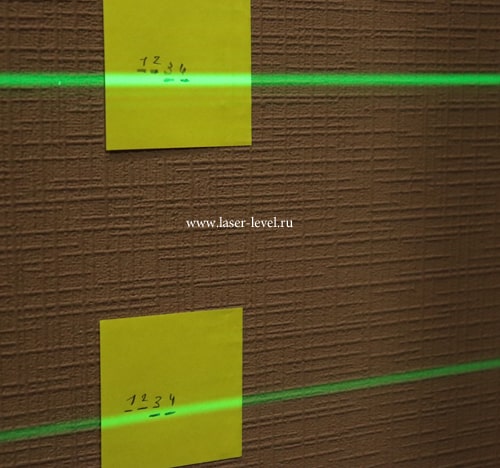
As you can see, both horizons are perfectly tuned! This is even somewhat surprising, since the level came with an unlocked compensator.
Checking verticals, oddly enough, showed the same excellent result. The only thing during the check was some kind of bug with switching planes: the "V" button switched horizons, the "H" button, on the contrary, verticals, in general, for some time there was complete confusion with switching planes and modes, then everything worked out ... What it was, I still did not understand.
The device turned out to be very accurate, but, unfortunately, it happens in another way. Therefore, let's take a look at how it is configured.
The device and principle of operation of the laser level
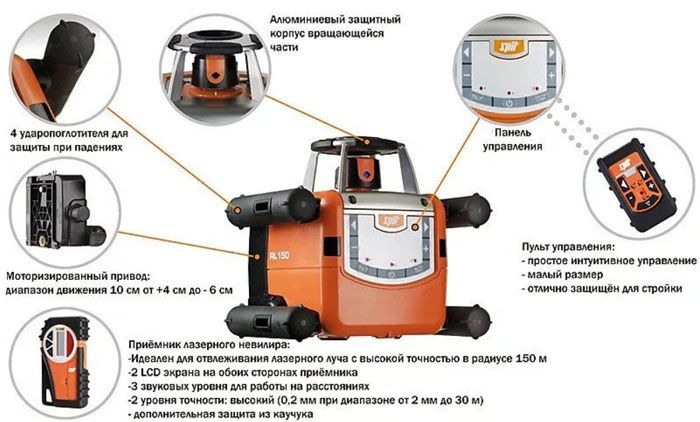 Laser level device.
Laser level device.
Consider the design and principle of operation of the laser level. The design of the device includes:
- Light source.
- Optical system.
- Installation mechanism and self-leveling device.
- Power supply (mains or battery)
- Controls: remote control and customizable panel.
- Frame.
Sources of light radiation, in these devices these are powerful LEDs, create a beam of a certain wavelength. Modern devices usually use red or green beams. They do not overheat the surface, do not consume a lot of energy.
For your information! It is believed that red rays with a long light wavelength of 635 nm are not very well perceived by the human eye. Therefore, in more expensive designs, green rays are used with a wavelength of 532 nm, which is more familiar to humans, which means that lines drawn with such a level will be seen better. This makes working with the green beam easier, even in sunny weather.
The optics built into the device reflects, directs and focuses the radiation in the direction in which it is necessary. The clarity of the beam, as well as the accuracy of the level itself, will depend on its quality.
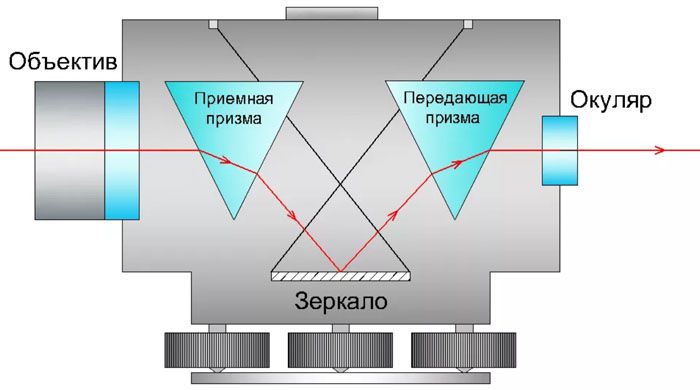 The optical system is a collection of prisms and lenses. It can be stationary, or it can have a rotating head.
The optical system is a collection of prisms and lenses. It can be stationary, or it can have a rotating head.
The setting mechanism is different for different types of laser level models. Budget models allow you to set the base of the level manually, while others have a built-in stabilization system. Such mechanisms work due to a pendulum and a magnetic field, which, when the part is deflected, generates an electric current, with the help of which the device is adjusted. The most advanced models capture the slightest fluctuations - in hundredths and tenths of degrees, which eliminates even the slightest inaccuracies in the process of marking surfaces.
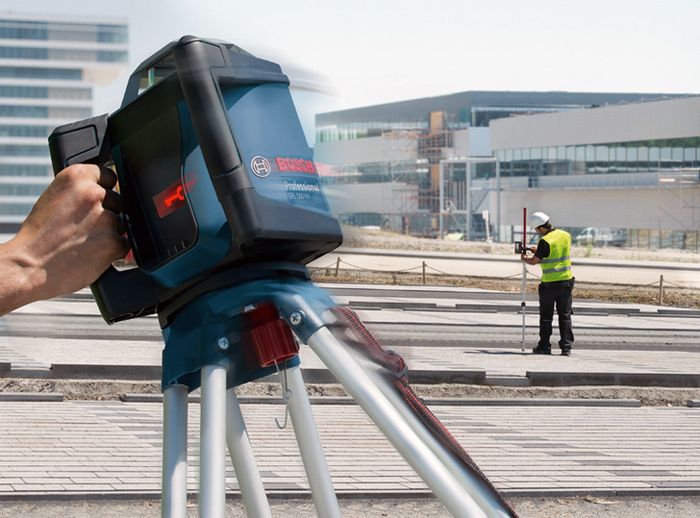 When a level equipped with a self-leveling system is tilted, it will start emitting a specific signal that will inform you about the displacement of the device from the specified coordinates.
When a level equipped with a self-leveling system is tilted, it will start emitting a specific signal that will inform you about the displacement of the device from the specified coordinates.
All such devices use rechargeable batteries. You can charge them using a special device included in the kit. Under constant load, the device is capable of operating in an autonomous mode for 7-10 hours without interruption.
The best models of laser levels overview of the main features with prices
Undoubtedly, among the best manufacturers, there are also the best models, which we will talk about in more detail.
Laser level Bosch GLL 3-80 P Professional
 Bosch GLL 3-80 is a professional line laser plane builder.
Bosch GLL 3-80 is a professional line laser plane builder.
Laser level 360 self-leveling Bosch GLL 3-80 is one of the most demanded in the professional equipment market. The maximum range of the device is 20 m, with a receiver 40 m. Accuracy is 02, mm / m. Draws 6 crosshairs at a 90 degree angle. Possibility of drawing 2 vertical lines. Vertical scan angle - 360 °. There is a self-leveling mechanism. Time of continuous work 18 hours.
You can buy such a self-leveling level for 19,000 rubles. The package includes a tripod and batteries.
Feedback on the Bosch GLL 3-80 P Professional model:
Read more on otzovik:
Laser level Bosch GCL 2-15 Professional
A laser level that performs both line and point projections. Works at a temperature of minus 10 degrees. Measurement range 15 meters. Accuracy 0.03 mm / m. The device works in two projections - vertical and horizontal.
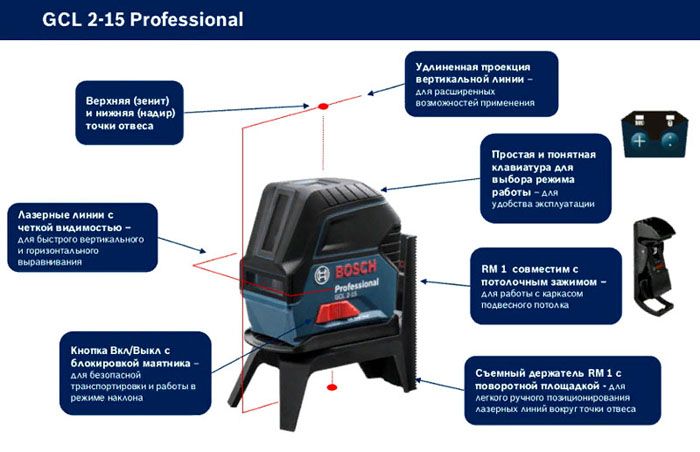 Features and characteristics of laser level Bosch GCL 2-15 Professional
Features and characteristics of laser level Bosch GCL 2-15 Professional
The set includes: tripod, holder, case and case, as well as a set of batteries. The price for this model is from 6500 rubles.
Feedback on the level Bosch GCL 2-15 Professional:
Read more on otzovik:
Laser level ADA TOPLINER 3 × 360
 Laser linear level ADA TOPLINER 3 × 360 will cost you 16,500 rubles.
Laser linear level ADA TOPLINER 3 × 360 will cost you 16,500 rubles.
An excellent model for semi-professional needs. Constructs projections both linearly and pointwise. Angle of vertical scanning 360 °. Measuring range 20 m without receiver, with receiver 50 m. Constructs 3 crosshairs at an angle of 90 °.Automatic leveling with the ability to disable. Time of continuous work - 8 hours.
Feedback on the ADATOPLINER 3 × 360 model:
 More details on Yandex.Market:
More details on Yandex.Market:
Instrumax Constructor 4D Laser Level
 The Instrumax Constructor 4D level is a universal device that should be in the garage (or on the balcony) of any master.
The Instrumax Constructor 4D level is a universal device that should be in the garage (or on the balcony) of any master.
Combined laser plane builder. Measurement range 20m. Accuracy 0.2 mm. Number of vertical lines 4, horizontal 1. Maximum work time - 8 hours
An important addition - the device can be connected to a regular outlet
The cost of such a model is 5000 rubles.
Feedback on Instrumax Constructor 4D model:
More details on Yandex.Market:
Laser level ADA CUBE 2-360 BASIC EDITION
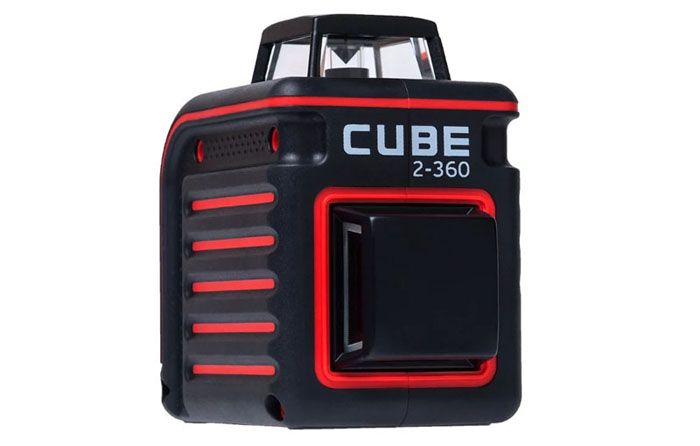 The small size and convenient shape of the laser level allows it to win the recognition of masters all over the world.
The small size and convenient shape of the laser level allows it to win the recognition of masters all over the world.
ADA CUBE 2-360 is a convenient and compact device with a long measurement range - up to 20 meters. Draws two crosshairs at 90 ° and one horizontal. Accuracy 0.3 mm / m. When using a receiver, the measurement range can be increased to 70 m. The horizontal scan angle is 360 °. The device is self-leveling. Time of continuous work 15 hours.
Feedback on the ADA CUBE 2-360 BASIC EDITION model:
Read more on otzovik:
How much a laser level that can be used at home and on a construction site costs depends on the region of purchase. The average price is from 9,500 thousand rubles.
Advantages and disadvantages
Devices with this design have a number of advantages in comparison with those for which cylindrical prisms with a short beam length are practiced.
- This is a naturally closed surface, spreading along the entire contour of the room, which makes it possible to mark the level in a circular manner at high speed and accuracy, without rotating the device itself.
- Higher exponentiality. You just need to turn on the device, and at once the scope of the upcoming work becomes clear.
- One of the most interesting advantages of these laser levels is that the projected surface can be installed quite close to the wall or ceiling.
Such functions make it possible to carry out many construction and repair tasks much faster and more comfortably. This advantage was especially noted by specialists in stretch ceilings, installation of doors, partitions and plastering works.
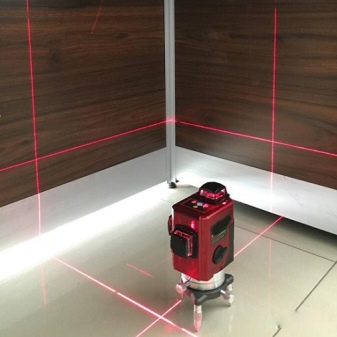

Any technical device has its own advantages and disadvantages. And here, too, there are disadvantages. Not to say that there are many of them, but there are a couple.
- This is undoubtedly the cost. All lasers with 3-360 optical design (in other words, 3 planes of 360 °) are quite expensive. Although now you can buy this device for a very reasonable price. The only thing is that you will have to wait a little while it will be brought from China.
- The second drawback is the often more uneven and bold beam in comparison with levels, where prisms in the shape of a cylinder are installed.
However, this feature is not available for all devices, but only for some, and what is the reason is unknown, one can only guess. It should be noted that it happens for all manufacturers, regardless of the brand.

Self-leveling laser level BOSCH GLL 2-10 Professional (0601063L00) for repair

- self-leveling;
- an error of no more than 4 degrees;
- beam length 10 m;
- builds crosshairs.
BOSCH GLL 2-10 Professional is a reliable construction tool from a good German brand. Allows you to create a crosshair of light lines. The model is light - 490 g, compact - 130 × 162 × 83 mm. The device is simple to use, it aligns itself horizontally with an error of no more than 4 degrees. The beam length is 10 m, but in low light the light beats up to 20 m as well. Builds 2 red lines. The beams are clearly visible in natural and artificial light. Laser class - 2. Costs 4,800-7,000 rubles.
Tripod mountable, 5/8 and 1/4 inch threaded holes. The unit is powered by 3 AA batteries. It is also possible to supply batteries of the same format.This is justified if you often have to work with the tool. On one set of batteries it can work 9 hours with two beams and 17 hours with one. You can work at temperatures between –10 ° C and 50 ° C. A convenient case is included in the package.
The device is convenient to use when laying the foundation, the tool is also suitable for finishing work, in particular for laying tiles and floor tiles.
Users are praised for a small error, self-alignment, good line visibility, and a storage case. Without a laser receiver, the beam hits at 10 meters, in dim lighting even at 20 m. Complaints about the absence of a bubble level cannot be set more accurately on your own.

Pros:
- an error of only 4 degrees;
- good beam visibility;
- the light hits at least 10 m;
- storage case;
- accurately builds crosshairs.
Selection Tips
Having familiarized yourself with the basic classification of self-leveling laser levels, you can proceed to the selection of a specific device
In order not to be mistaken, it is necessary to focus on certain characteristics of the device.
Measurement error
In inexpensive devices, the accuracy of determining the horizontal position does not meet the requirements - the deviation can reach up to 3 millimeters per 10 meters of distance. Of course, there is no need to talk about any horizontal position.
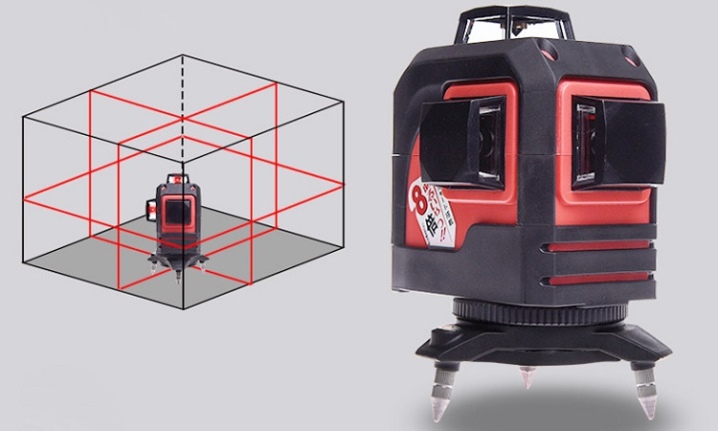
Measurement range
The determination of this indicator can be carried out by diameter or radius. The admissibility of working with the receiver is also fundamental.
It is necessary to find out the technical parameters of the laser device: the length of the light waves, the radiation power. As a rule, the first indicator is equal to 635 nm. In this situation, the beam comes out orange-red. When the wavelength is 532 nm, the color of the beam will be green.

Self-leveling angle
Bad choice - about 3 degrees. In this situation, it will be necessary to constantly level the position of the level with your hands. And also the device must be able to turn off the automation.

The usual protection by means of rubber inserts is enough to use the level both in the rain and in dust.
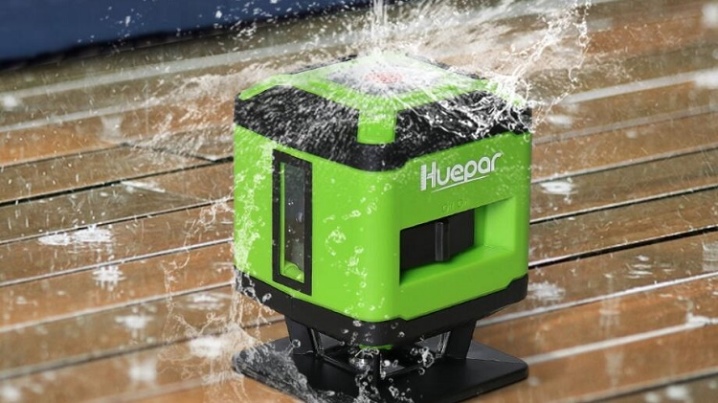
Contents of delivery
It can include glasses for better visual perception of laser radiation, a receiver, fasteners, a tripod, a control panel, and more.


Rating of the best models
At the moment, there are 5 most popular models of levels with cone-shaped prisms projecting 3 planes of 360 °.
- For a long time, the first place has been held by the GLL 3-80 C Professional device from Bosch from Germany, only for the domestic market it is manufactured, imagine, in China.
- On the 2nd place is the ADA Top Liner laser level from ADA Instruments from China.
- The third place is occupied by a new brand from China Firecore, which produces the F93T-XR device.
- The 4th and 5th places with the smallest gap between themselves are taken by 2 manufacturers from China's budget laser levels: Xeast 12 and KaiTian 3D.
Rating of manufacturers of laser levels
Our editors have compiled a rating of level manufacturers based on customer preferences for May 2018. So, we have identified 7 brands that were in demand among Russian users.
| Logo | Manufacturer country | Brand | Place in the rating according to the editorial board |
 |
Germany | Bosch | 1 |
 |
USA, European and Asian countries | ADA | 2 |
 |
China | Instrumax | 3 |
 |
Russia | Condtrol | 4 |
 |
Russia | Elitech | 5 |
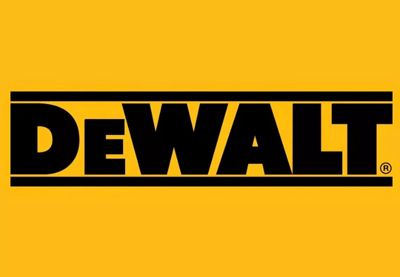 |
USA | DeWalt | 6 |
 |
Russia | Zubr | 7 |
Interestingly, according to the rating, Russians were more attracted to laser equipment with the following characteristics:

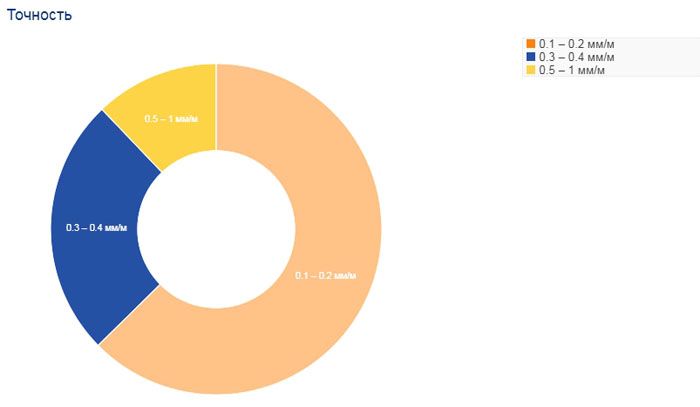

And so the preferences were distributed regarding additional components and accessories.
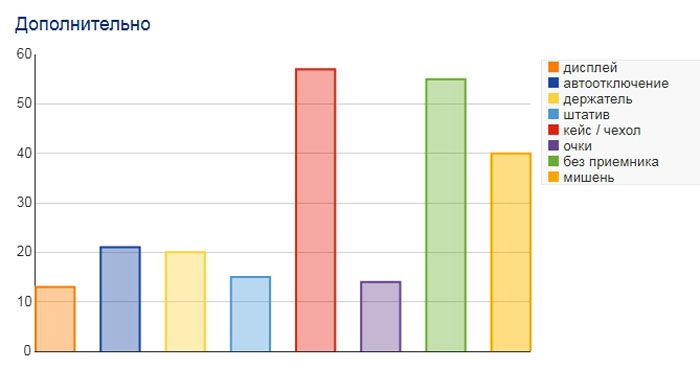
Advantages and disadvantages of a construction laser level
Measuring devices of this type are distinguished by high accuracy, wide functionality and ease of use. Almost all models of professional laser levels are programmable. For example, you can set projection in a certain plane, projection clearly by points or at a certain angle.Moreover, in all cases, the device will build perfectly straight lines relative to its position in space.
 Laser level Bosh PSL 10 Set - helps to change the angle of view during repair work
Laser level Bosh PSL 10 Set - helps to change the angle of view during repair work
There are many advantages to using a laser level.
- Saves time. The device does not need to be specially prepared, started or adjusted. Smart technology will do everything by itself. It is estimated that the device almost twice saves time when carrying out marking work.
- Measurements are obtained as accurate as possible, because the error in most devices does not exceed 1 mm per meter.
- The device can be installed as close to a corner as possible, or even mounted on a wall.
- The device is able to cover the entire field at once for work. You can immediately mark the places where you will hang a chandelier, nail shelves or perfectly evenly divide the room with a partition.
- The device is quite easy to use and does not require additional knowledge.
 Sometimes it is very necessary to measure the level at a certain height. New generation lasers will help you do this effortlessly.
Sometimes it is very necessary to measure the level at a certain height. New generation lasers will help you do this effortlessly.
Among the disadvantages is the need to control batteries (purchase, replacement, charging), as well as the tangible high cost of the device.
For your information! In cheaper models, conventional rechargeable batteries are used, and in more advanced devices, nickel-cadmium batteries. They can provide uninterrupted operation of the laser for 10 hours or more.
Control
Like many current levels, a touchscreen control panel is used here, although it has some problems with the stability of the response. The panel may not always respond to touch and is not always correct. So, for example, when you press the "H" button, you can suddenly turn on the vertical, although logically this should not be.
Again, if not to judge strictly, then for the money it is quite passable touch panel.
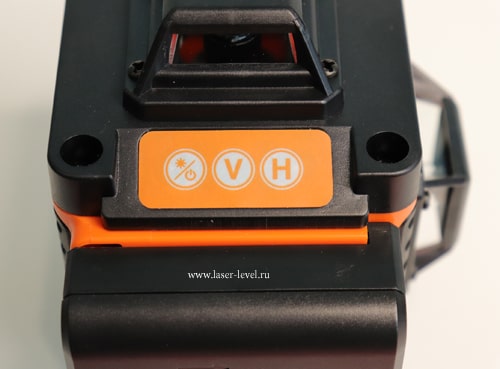
Button "H" - switches horizons separately: 1 lower, 1 upper, or both together.
Button "V«
- switches verticals: one, the second, or both together. Thus, you can choose absolutely any plane.
And the third button - when pressed briefly, it lowers the brightness of the glow, it is very similar to switching to a pulsating mode for working with a receiver on the street, but most likely this is just brightness adjustment. And its second purpose, when pressed for a longer time, is to turn on the tilted operating mode, for marking at any arbitrary angle, but you need to be careful, since the compensator is not blocked at this moment.
In the back, under the battery, there is a toggle switch for turning the level on and off, which is also responsible for locking and unlocking the compensator.

Also, all planes can be controlled from the remote control that comes with the kit. The remote has only two buttons "H" and "V".
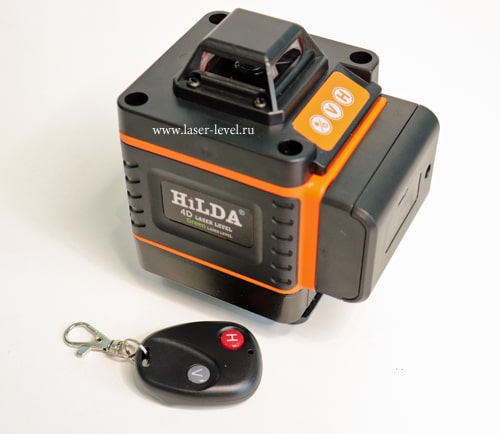
Device and principle of operation
Let's consider the structure and principle of operation of a laser level. The structure of the device includes:
- frame;
- light source;
- optical devices;
- installation mechanism and self-leveling system;
- source of electricity supply (network or batteries);
- control tools - customizable panel and console.

The sources of light radiation in these devices are powerful light-emitting diodes that create a beam of a specified wavelength. In modern devices, as a rule, red or green rays are practiced. They do not overheat the surface, do not waste a large amount of electricity.
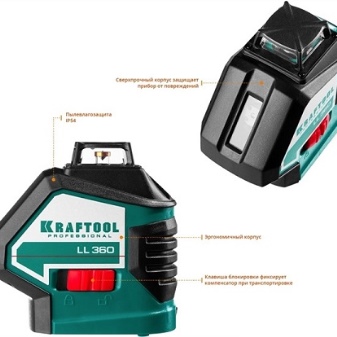

The LED device emits a luminous flux. Then this stream is transformed into a laser beam passing through a lens or a prism, and is transferred to the object to which the level is oriented. The distance to which the device is capable of transmitting the beam can reach up to several tens of meters. The simplest laser levels project 1-2 beams, professional ones - up to 9. The more beams, the easier the marking is applied.For example, a few cross beams will make it easier to manage when laying tiles. And 4 lines will make it possible to make markings in different planes.
Batteries are practiced in the levels. You can charge them using a specialized device, it is included in the kit. With a stable load, the device is capable of operating in an autonomous mode for approximately 7-10 hours continuously.
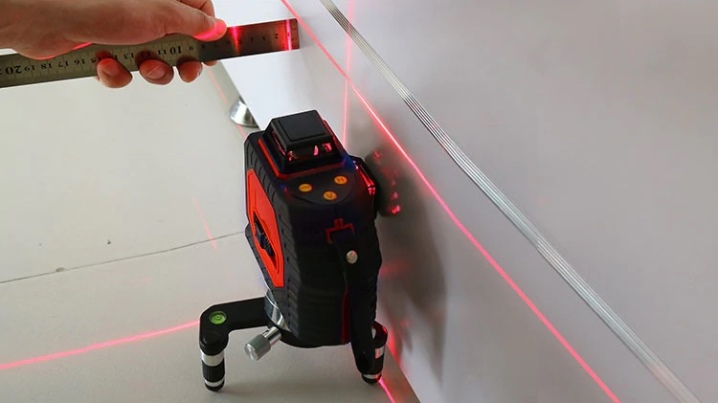
Frame
I must say right away that it is not worth waiting for high build quality and materials for such a price, it is simply impossible. Although, in fairness, if you look at the picture as a whole, it seems as if the HILDA 4D laser level looks quite neat, at least several times better than the younger model Hilda 3D LS055 Green. The plastic used is also cheap, but at least there are no those terrible splashes and glue drips.

Such a low cost of the device can be explained only by the installation of very cheap laser modules in general, which do not cost even one dollar. Therefore, the question of the lifetime of laser emitters for such levels remains open. In the vastness of Aliexpress, you can find many similar models under different names: PRACMANU, HAVADOU and others, the cheapest laser modules are used everywhere.

Good quality LD laser modules such as Sharp or Osram cost between $ 8 and $ 12 apiece. Even if you counted on the average, at $ 10, then the modules alone would come out to $ 40, since there are 4 of them. But you also need the case itself, glass, compensator, electronic components, battery. And the package itself is not poor. In general, such a low price, for me personally, still remains a mystery.
There is no battery compartment as such in HILDA 4D, the battery is simply installed on top of the case.

The plastic protective towers are fixed with four bolts, but again without any rubber gaskets, as, for example, in the higher quality HUEPAR 904DG level. Such gaskets are essential to protect internal electronic components from moisture and dust.
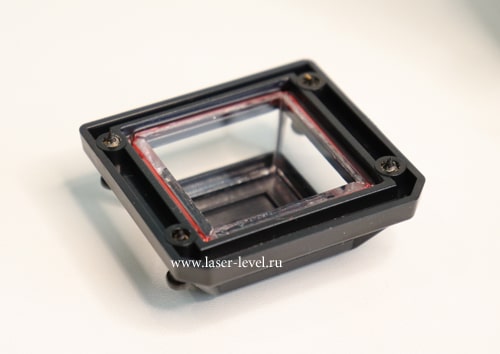
Of the advantages, one can single out the ability to operate the device from the network. In addition, the battery can be charged separately from the device. This is convenient enough for smooth operation, but only if you have a second battery.
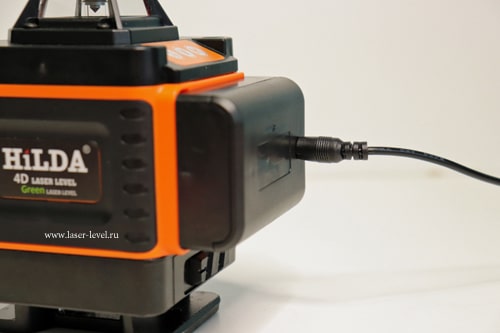
The lower part of the body, which is also the lower protective tower of the emitter and a kind of platform for installing the level, is made of metal. There are also two small holes in it, but only one of them has a 1/4 "inch tapped thread for mounting on a tripod, rod or any other mount with the same mounting screw thread.
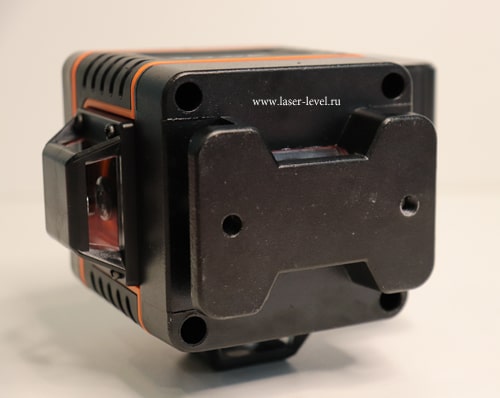
Separately, I would like to say about the small size of the HILDA 4D laser level. Compared to a professional laser level with the same optical design (4 * 360º) - FUKUDA MW-94D-4GX, it looks no less compact.

The supplied battery is very easy to disassemble and consists of two
, therefore, if desired or necessary, these elements can be easily replaced.

Contents of delivery
The Hilda 4D is delivered in a bag - a case with thick walls, which protects the device well from mechanical stress. The basic kit, in addition to the main device, also includes: an adapter from 5/8 ″ to 1/4 ″, one battery, charger, metal plate, remote control, instructions, lifting platform, magnetic wall mount.
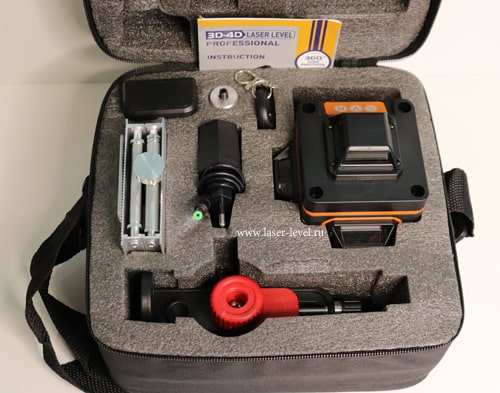
The level can be attached to a magnetic mount directly through the thread in the base, or through a special adapter - a clamp for the protective upper tower. The bracket is made very mediocre, it does not fix the device on the thread well, and on smooth magnetic surfaces it slides down under the weight of the level. This is also due to the fact that there are no rubber pads in the part where the magnets are installed.

The lifting platform has a lifting range of the working surface from 2.5 to 8.5 centimeters. Quite a handy thing for working with floors.
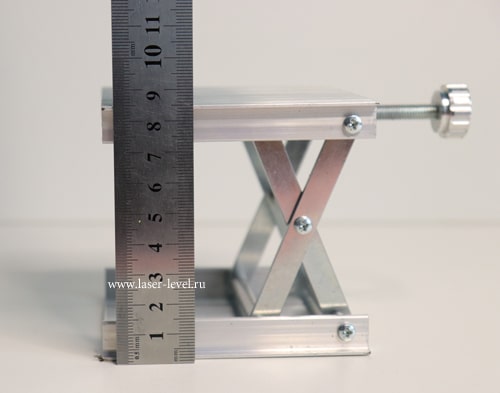
How to order a level from China?
It is completely safe and very profitable to order a professional laser level directly from China!
The only thing is, you have to wait a bit. Those who took advantage of this opportunity were very pleased with the quality and functionality of the levels for incomparably less money.
You can choose a high-quality and inexpensive laser level with free shipping from China on one of two proven sites:
The best prices!
Lowest prices! (When you go to the site search, enter - Laser Level)
The ordering process is very simple, everyone can figure it out in a couple of minutes. And since in most cases the delivery is absolutely free, it all comes down to a simple algorithm - you chose, paid and received at your post office or at home by courier.
Setting up HILDA 4D
The alignment of this level is quite simple, but it is necessary to know some sequence of adjustment.
In this model, the position of the lower horizon (laser module) is absolutely precisely adjusted by the position of the pendulum, that is, the transverse and longitudinal adjustment screw (see photo below).
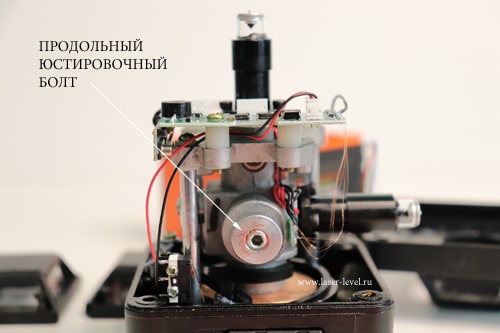
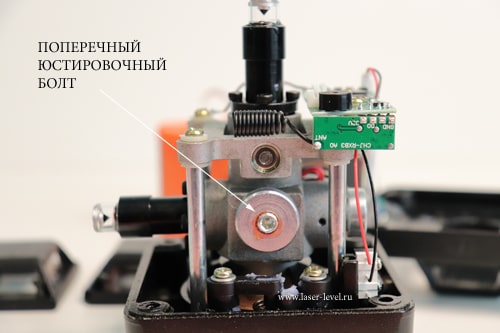
All other laser modules are self-configuring individually with four hex bolts at the base of the laser tube.
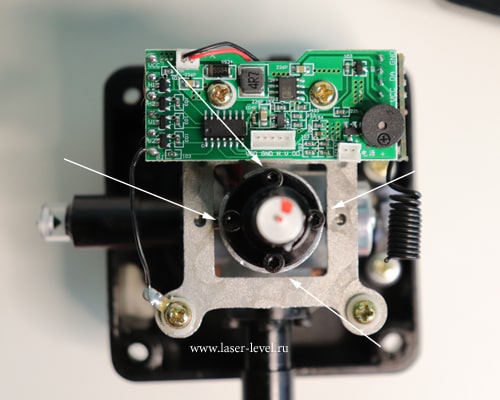
Thus, if your lower horizon shows exactly, and the error is present in other planes (both verticals and the upper horizon), no matter in what sequence and number, then there is no need to disassemble the entire device. You just remove the protective tower of the module whose position needs to be corrected and make adjustments. and quietly remove the main part of the case (it is not difficult to disassemble), but you will have to disconnect the power and keyboard connectors
Then reconnect and insert the battery, it will be a little inconvenient, but quite real.
And if the bottom horizon "lies" in addition to everything, then first you need to disassemble the case, unscrew 4 screws from the top, then 4 screws from the bottom and unscrew both towers from the verticals, and quietly remove the main part of the case (it is not difficult to disassemble), but you will have to disconnect the power connectors and keyboard. Then reconnect and insert the battery, it will be a little inconvenient, but quite real.
Next, set the position of the lower horizontal plane with the longitudinal and transverse bolts of the pendulum, and only after adjusting the lower horizon, you can start adjusting the remaining planes separately, having previously assembled the body back.
Attention! After correcting the lower horizontal plane, be sure to check all other planes for accuracy again, they may not need adjustment.
After adjustment, it is recommended to lubricate all adjustment bolts with regular nail polish.

